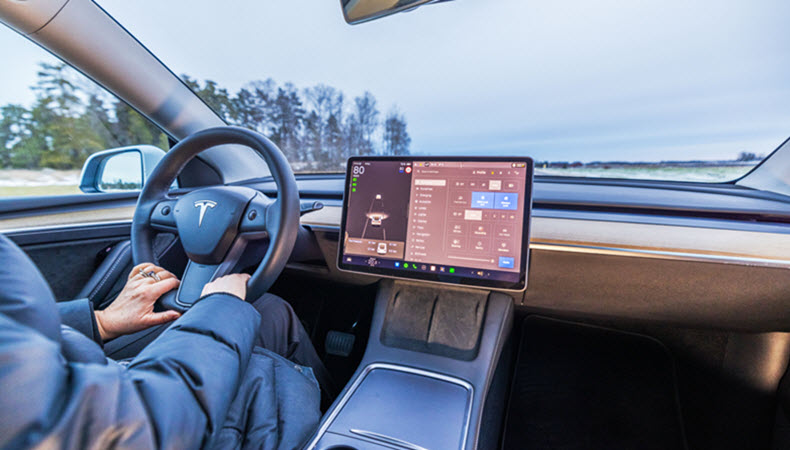The most common and unsettling issues for some Tesla owners are instances of phantom braking, where the car slows down for no apparent reason. The problem is associated with the Autopilot and traffic-aware cruise control system, which is reportedly caused by the vehicle’s vision-based systems misinterpreting shadows, road signs, or other environmental factors as obstacles.
Tesla released software updates to address the issues that can be a dangerous experience for drivers and those following behind them. Learning how to manage and mitigate phantom braking is crucial for maintaining drivers’ confidence and ensuring road safety.
Tesla Handling Tips To Prevent Phantom Braking
The most powerful tool against phantom braking is direct intervention. Because the Auto Pilot is a driver assist system that is not fully autonomous, it requires the driver to remain fully attentive and ready to take control at all times.
Override with the accelerator
The simplest and most immediate way to counteract phantom braking is to gently press the accelerator pedal. This tells the car that you are in control and overrides the system’s braking command. This is useful for minor and momentary braking events that you can predict or anticipate.
Disengage autopilot immediately
For a more severe braking event, tap the brake pedal to instantly disengage the Autopilot. This allows you to regain complete manual control of the vehicle.
Keep your foot poised over the pedal
Tesla owners recommend developing a habit of driving with your foot hovering near the accelerator pedal when using Autopilot. This allows a quicker override, turning the event smoother and more controlled.
Maintain situational awareness
Always be vigilant for the environmental conditions that often trigger phantom braking. This can include –
- Driving over any overpasses or bridges
- Approaching large reflective vehicles like semi trucks
- Facing direct sunlight or other glare
- Driving in heavy rain, fog, or snow
- Encountering faded or complex road markings
Anticipate and Take Over
Knowing the location or specific driving conditions that consistently trigger phantom braking, and being prepared to take over manual control of the vehicle before the event occurs.
Optimizing Vehicle Settings
- Change cruise control speed behavior: In your autopilot settings, change the set speed option from speed limit to current speed. This prevents the car from automatically adjusting its speed when it misreads a speed limit sign, such as one on a highway off-ramp or on the back of another vehicle.
- Adjust forward collision warning: Consider setting the forward collision warning to ‘early’ or ‘medium’. This can provide an earlier audible and visual alert to a perceived threat, allowing more time to prepare for a potential phantom brake event.
- Understand automatic emergency braking: Some drivers have found success in temporarily disabling the automatic emergency braking system. This is a critical safety feature that works independently of Autopilot and should be used with extreme caution. Disabling it for a specific drive may reduce the false positives, but it also disables the system’s ability to automatically brake in an emergency. This AEB setting also gets reset with every new drive cycle.
- Keep all cameras clean: The Tesla vision system relies on its cameras. So, keeping them clear of dirt, rain spots, dust, and ice is critical. A dirty camera can misinterpret its surroundings and trigger a phantom brake event. Regularly cleaning the camera lenses located on the pillars, windshields, and fenders.
Reporting the Problem to Tesla
Providing Tesla with data on phantom braking events is crucial for helping the company diagnose and fix the problem. The more data they receive, the better their repair results will be.
- Use the voice command bug report: When a phantom brake event occurs, immediately use the voice command by saying Bug Report. This action takes a snapshot of the vehicle’s system, location, and data, sending it to Tesla’s development team for analysis.
- Document and communicate: After sending a bug report, schedule a service appointment and explain the issue. Give a detailed explanation that includes the location, conditions, and nature of the phantom braking incident. This ensures that our service technicians can properly review the specific event.
Phantom Brakes and Peace of Mind: A Guide for Tesla Owners in Herndon, VA
For those who find themselves frustrated by such unpredictable vehicle behavior, there is a better alternative. The Auto Scandia, located in Herndon, VA, is known for its expertise and precision engineering that the Tesla Vision system currently lacks. The professionals at Auto Scandia specialize in providing reliable, trustworthy service and repairs for European cars. With years of hands-on expertise, our certified technicians ensure every vehicle is maintained to the highest standards, promising a steady and worry-free journey. At Auto Scandia, performance meets passion, and we are committed to delivering the ultimate driving experience that your vehicle and your safety deserve.
* Man Driving Tesla Model 3 Electric Car image credit goes to: Alexander Shapovalov.

 Mon – Fri: 8am – 6pm
Mon – Fri: 8am – 6pm  134 Spring Street
134 Spring Street  (703) 471-4494
(703) 471-4494
